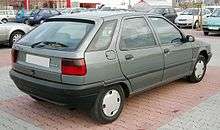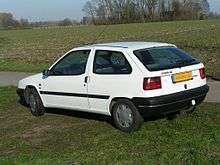Citroën ZX
| Citroën ZX | |
|---|---|
 | |
| Overview | |
| Manufacturer | Citroën |
| Also called | Citroën Fukang (China) |
| Production |
1990–1998 1994–2009 (China) |
| Assembly |
France: Rennes (PSA Rennes Plant) Spain: Vigo (PSA Vigo Plant) Uruguay: Barra de Carrasco (Oferol) |
| Designer | Bertone |
| Body and chassis | |
| Class | Small family car (C) |
| Layout | FF layout |
| Related |
Citroën Xsara Citroën Elysée Peugeot 306 |
| Chronology | |
| Predecessor | Citroën GS (1970–1986) |
| Successor | Citroën Xsara |
The Citroën ZX is a small family car produced by the French manufacturer Citroën between 1991 and 1998.
During the early 1990s, the ZX was Citroën's competitor in the class traditionally dominated in Europe by the Ford Escort and Vauxhall/Opel Astra, a market segment Citroën had briefly moved away from with the demise of the GSA in 1986.[1]
The BX had tried to address the small family car market and the large family car market by being 'between sizes' but well packaged. For 1993, the Citroën ZX chassis was also used for the Peugeot 306 which, with its attractive Peugeot 205 derived styling, was an even more successful car than its twin. The Citroën Berlingo and Peugeot Partner were also built on the same platform.
In September 1997, it was replaced by the Xsara, but production in Europe continued until 1998. A saloon derivative, called the Citroën Elysée, continued to be produced for the Chinese market by the Dongfeng Peugeot-Citroën Automobile, a joint venture with the PSA Group.
Overview



By 1988, Citroen was working on a new C segment hatchback, which was originally expected to be launched as the Citroën FX, some time around 1990. The ZX was launched on 16 March 1991, with British sales beginning in May that year, initially only with petrol engines. The diesel ZX went on sale later in 1991.[2]
It went on sale in New Zealand in the beginning of 1993, as a five door in 1.6 Aura or Turbodiesel trim, with the naturally aspirated diesel and Volcane GTi (1.9) models joining a few weeks later. New Zealand's unleaded petrol was of a low octane rating, meaning that initially only uncatalyzed cars were on offer.[3] In January 1994, the ZX estate debuted and went on sale in May, shortly followed by a mid cycle facelift.
The first examples of the ZX had been produced in 1990, with the three door Rally Raid model being the winner of the Paris-Dakar, which started just after Christmas. The first prototypes of the ZX had actually debuted at the Baja Aragon on 20 July 1990. Drag resistance ranged from Cds 0.30 to 0.33.[4]
The launch of the ZX marked the return of Citroën into the C-sector of the car market; it had discontinued the GSA in 1986 with no immediate replacement, largely due to the success of the larger BX. However, Citroën had decided to phase out the BX between 1990 to 1993, by at first launching a smaller model, and then adding a larger model (the Xantia) to its range.
The ZX's interior space and value received praise from critics and consumers. Of particular note was the rear seat arrangement; it was mounted on a sliding platform that allowed the seat to be moved rearwards to increase rear legroom, or forwards to increase cargo space. Unfortunately, only the seat backs folded down on models so fitted. Lower specification models with fully folding and removable seats had more ultimate capacity.
The ZX specification was good for its class, with most models getting power steering, electric windows, electric sunroof, a driver's side (and sometimes passenger's side) airbag and anti-lock braking system as either optional or standard equipment. It was competitively priced though, unlike the Mark III Volkswagen Golf, which was priced at a relative premium from its launch later in 1991. It also reached the market a few months before the new version of the Opel/Vauxhall Astra.
The familiar range of PSA powertrains drove the front wheels of a seemingly conventionally designed chassis. At the front was a standard MacPherson strut layout with anti-roll bar, while the rear used the PSA Peugeot-Citroën fully independent trailing arm/torsion bar set up that was first introduced on the Peugeot 305 estate. However, PSA's chassis engineers employed some unusual features, including passive rear wheel steering (by means of specially designed compliance bushes in the rear suspension), and in house developed and constructed shock absorbers.
At high mileages, this is prone to wear off the axle mounting bushes, which is easily fixed. It is also prone to wear in the rear axle trailing arm bearings, which then wear the trailing arm axle tubes, requiring an expensive rebuild or a replacement axle assembly.[5][6][7][8][9] The diesel and larger capacity petrol engines are canted as far back as possible in the engine bay, in an effort to put as much weight as possible behind the front axle line, also reducing the centre of gravity, while improving weight distribution and minimising understeer.
Trim levels
At the time of its launch, the ZX range consisted of a collection of four very individual trim levels; the base model was the "Reflex" aimed at young people, next was the "Avantage" aimed at families, and then there was the luxury "Aura" series. The final series was the relatively sporting "Volcane" series, with lowered (and hard) suspension. The "Volcane" TD was one of the first diesel hot hatches.
Over time, further models were introduced including the "Furio", a cheaper sports model, a 16 valve engined high performance derivative and many special editions.
Engines
The ZX was initially available as a three or five door hatchback, while a five door estate was added to the range in 1993. It was offered with petrol engines from 1.1 L to 2.0 L, as well as three 1.9 L diesel engines including a turbodiesel. However, the 1.1 petrol engine was never sold in Britain.
- 1.1 L (1124 cc) TU1 I4, 60 PS (44 kW; 59 hp), 91 N·m (67 lb·ft)
- 1.4 L (1360 cc) TU3 I4, 75 PS (55 kW; 74 hp), 120 N·m (89 lb·ft)
- 1.6 L (1587 cc) TU5 I4, 90 PS (66 kW; 89 hp), 135 N·m (100 lb·ft)
- 1.8 L (1761 cc) XU7 I4, 103 PS (76 kW; 102 hp), 153 N·m (113 lb·ft)
- 1.8 L (1761 cc) XU7 I4, 112 PS (82 kW; 110 hp), 155 N·m (114 lb·ft)
- 1.9 L (1905 cc) XU9 I4, 130 PS (96 kW; 128 hp), 170 N·m (125 lb·ft)
- 2.0 L (1998 cc) XU10 I4, 123 PS (90 kW; 121 hp), 176 N·m (130 lb·ft)
- 2.0 L (1998 cc) XU10 I4, 150 PS (110 kW; 148 hp), 183 N·m (135 lb·ft)
- 2.0 L (1998 cc) XU10 I4, 167 PS (123 kW; 165 hp), 198 N·m (146 lb·ft)
- 1.8 L (1769 cm3) 60 HP
- 1.9 L (1905 cc) XUD9 diesel I4, 65 PS (48 kW; 64 hp), 120 N·m (89 lb·ft)
- 1.9 L (1905 cc) XUD9 diesel I4, 71 PS (52 kW; 70 hp), 125 N·m (92 lb·ft)
- 1.9 L (1905 cc) XUD9 diesel I4, 91 PS (67 kW; 90 hp), 148 N·m (109 lb·ft)
Sales and production
| Year | Worldwide Production | Worldwide sales | Notes |
| 2009 | 76,000[10] | 75,500[10] | |
| 2010 | 72,000[10] | 71,800[10] | |
| 2011 | 66,327[11] | 65,545[11] | Total production reaches 2,526,363 units.[11] |
| 2012 | 55,600[12] | 55,600[12] | Total production reaches 2,582,000 units.[12] |
| 2013 | 55,100[13] | 55,900[13] | Total production reaches 2,637,100 units.[13] |
Motorsport
The car won the 1994 Paris–Dakar Rally, and again twice more in the following two years.
References
- ↑ "CITROEN GS/GSA | car specs | octane". Classicandperformancecar.com. Retrieved 2011-03-05.
- ↑ Julian Marsh. "Citroën ZX". Citroenet.org.uk. Retrieved 2011-08-07.
- ↑ Anderson, Donn, ed. (March 1993). "Sweet Package". New Zealand Car. Auckland, New Zealand: Accent Publishing Cnr. 7 (5): 44. ISSN 0113-0196.
- ↑ Sweet Package, p. 46
- ↑ "Zx Volcane Rear Suspension – Technical Section".
- ↑ "ZX rear swing arm bearings – Technical matters – Back Room Forum – Honest John".
- ↑ http://www.docstoc.com/docs/122038287/Citroen-ZX-Suspension-and-steering
- ↑ "ZX Radius arm bearings – French Car Forum".
- ↑ http://www.sspengineering.co.uk/
- 1 2 3 4 "Engine specs from PSA Peugeot Citroën" (PDF). Creator and designer. PSA Peugeot Citroën. Retrieved 4 December 2012.
- 1 2 3 "PSA Annual Report 2012" (PDF). Car manufacturers. PSA. Retrieved 1 May 2013.
- 1 2 3 "Memento Mars 2013" (in French). PSA Peugeot Citroën. 21 February 2013: 50. Retrieved 31 July 2013.
- 1 2 3 "Memento Mars 2014" (in French). PSA Peugeot Citroën. March 2014: 54,65. Retrieved 2014-09-26.
External links
| Wikimedia Commons has media related to Citroën ZX. |
| « previous — Citroën car timeline, 1980s–present | ||||||||||||||||||||||||||||||||||||||
|---|---|---|---|---|---|---|---|---|---|---|---|---|---|---|---|---|---|---|---|---|---|---|---|---|---|---|---|---|---|---|---|---|---|---|---|---|---|---|
| Type | 1980s | 1990s | 2000s | 2010s | ||||||||||||||||||||||||||||||||||
| 0 | 1 | 2 | 3 | 4 | 5 | 6 | 7 | 8 | 9 | 0 | 1 | 2 | 3 | 4 | 5 | 6 | 7 | 8 | 9 | 0 | 1 | 2 | 3 | 4 | 5 | 6 | 7 | 8 | 9 | 0 | 1 | 2 | 3 | 4 | 5 | 6 | 7 | |
| Economy car | 2CV | |||||||||||||||||||||||||||||||||||||
| Off-roader | Méhari | |||||||||||||||||||||||||||||||||||||
| City car | C1 I | C1 II | ||||||||||||||||||||||||||||||||||||
| Supermini | LN / LNA | AX | ||||||||||||||||||||||||||||||||||||
| Dyane | Axel | Saxo | C2 | DS3 | ||||||||||||||||||||||||||||||||||
| Visa | C3 I | C3 II | C3 III | |||||||||||||||||||||||||||||||||||
| Small family car | GSA | ZX | Xsara | C4 I | C4 II | |||||||||||||||||||||||||||||||||
| C-Elysée | ||||||||||||||||||||||||||||||||||||||
| DS4 | ||||||||||||||||||||||||||||||||||||||
| Large family car | BX | Xantia | C5 I | C5 II | ||||||||||||||||||||||||||||||||||
| DS5 | ||||||||||||||||||||||||||||||||||||||
| Executive car | CX | XM | C6 | |||||||||||||||||||||||||||||||||||
| Convertible | Visa cabriolet | C3 Pluriel | E-Méhari | |||||||||||||||||||||||||||||||||||
| Mini MPV | Nemo Multispace | |||||||||||||||||||||||||||||||||||||
| Compact MPV | Xsara Picasso | C3 Picasso | ||||||||||||||||||||||||||||||||||||
| C4 Picasso I | C4 Picasso II | |||||||||||||||||||||||||||||||||||||
| Large MPV | Evasion | C8 | ||||||||||||||||||||||||||||||||||||
| Mini crossover | C4 Cactus | |||||||||||||||||||||||||||||||||||||
| Crossover SUV | C-Crosser | C4 Aircross | ||||||||||||||||||||||||||||||||||||
| LAV | Acadiane | C15 | Nemo | |||||||||||||||||||||||||||||||||||
| Berlingo | Berlingo II | |||||||||||||||||||||||||||||||||||||
| Van | H Van | C25 | Jumpy I | Jumpy II | Space Tourer | |||||||||||||||||||||||||||||||||
| C35 | Jumper I | Jumper II | ||||||||||||||||||||||||||||||||||||